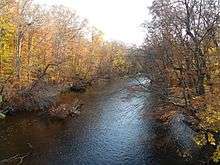Passaic River
The Passaic River (/pəˈseɪ.ɪk/ pə-SAY-ik) is a river, approximately 80 mi (129 km) long,[1] in northern New Jersey in the United States. The river in its upper course flows in a highly circuitous route, meandering through the swamp lowlands between the ridge hills of rural and suburban northern New Jersey, called the Great Swamp, draining much of the northern portion of the state through its tributaries. In its lower portion, it flows through the most urbanized and industrialized areas of the state, including along downtown Newark. The lower river suffered from severe pollution and industrial abandonment in the 20th century. In April 2014, the U.S. Environmental Protection Agency (EPA) announced a $1.7 billion plan to remove 4.3 million cubic yards of toxic mud from the bottom of lower eight miles of the river. It is considered one of the most polluted stretches of water in the nation and the project one of the largest clean-ups ever undertaken.[2]
| Passaic River | |
|---|---|
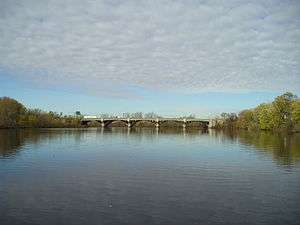 Passaic River in Bergen and Passaic Counties | |
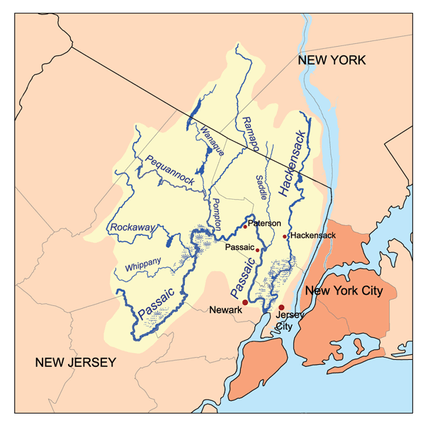 The Passaic and Hackensack watersheds | |
| Location | |
| Country | United States |
| State | New Jersey |
| Counties | Hudson, Essex, Bergen, Passaic, Morris, Union, Somerset |
| District | Northern New Jersey, Gateway, Skylands |
| Cities | Newark, Paterson, Passaic |
| Physical characteristics | |
| Source | Unnamed Pond |
| • location | Mendham |
| • coordinates | 40°45′44″N 74°34′39″W |
| • elevation | 540 ft (160 m) |
| Mouth | Newark Bay |
• location | Newark |
• coordinates | 40°42′46″N 74°07′08″W |
• elevation | 0 ft (0 m) |
| Length | 80 mi (130 km) |
| Basin size | 935 sq mi (2,420 km2) |
| Discharge | |
| • location | Little Falls |
| • average | 2,100 cu ft/s (59 m3/s) |
| • minimum | 36 cu ft/s (1.0 m3/s) |
| • maximum | 8,330 cu ft/s (236 m3/s) |
| Discharge | |
| • location | Chatham |
| • average | 320 cu ft/s (9.1 m3/s) |
| Basin features | |
| Tributaries | |
| • left | Rockaway River, Pompton River, Saddle River |
| • right | Dead River |
Course
The Passaic rises in the center of Mendham, in southern Morris County. It begins between Spring Hill Road and Hardscrabble Road, travelling northeast and crossing Corey Lane before entering the Buck Hill Tract Natural Area. At this point the river begins to generally flow south, through Morristown National Historical Park, and forms the boundary between Morris and Somerset counties. In its current path, it passes through the southeast edge and drains Lord Stirling Park then along the western edge of the Great Swamp, which it drains through several small tributaries including Black Brook. The river passes through a gorge in Millington and then turns abruptly northeast, flowing through the valley between Long Hill to the west and the Second Watchung Mountain to the east.
It forms the boundary between Morris and Union counties as it passes Berkeley Heights, New Providence, and Summit. Near Chatham it turns north, forming the boundary between Morris and Essex counties. It passes Livingston and Fairfield, where it flows through the Hatfield Swamp and is joined by the Rockaway River just after the Whippany River runs into it. Southwest of Lincoln Park it passes through the Great Piece Meadows, where it turns abruptly eastward and is joined at Two Bridges (two bridges road) by its major tributary, the Pompton River, then meandering through Little Falls, New Jersey as it drops over a fall, across some rapids, and under Passaic County Route 646 and an abandoned railroad trestle.
The river flows northeast into the city of Paterson, where it drops over the Great Falls of the Passaic. On the north end of Paterson, it turns abruptly south, flowing between Paterson and Clifton on the west and Hawthorne, Fair Lawn, Elmwood Park, Garfield on the east, next through the city of Clifton. At Elmwood Park it begins to form Dundee Lake, created by the Dundee Dam built in 1845. The river becomes navigable two and a half miles downstream of the Dundee Dam at the Eighth Street/Locust Ave Bridge in Wallington where the dredged Wallington Reach channel begins.[3] Proceeding beyond the Wallington Reach, the river remains navigable via a series of maintained channels to its final destination, Newark Bay. It passes Passaic, Clifton again, then Nutley and Belleville on the west; it flows past Rutherford, Lyndhurst and North Arlington to the east.
In its lowest reaches, it flows along the northeast portion of the city of Newark on the west, passing Kearny, East Newark, and Harrison, New Jersey on the eastern bank. Near downtown Newark it makes an abrupt easterly bend, then south around Ironbound, joining the Hackensack River at the northern end of Newark Bay, a back bay of New York Harbor.
History
Geology
The Passaic River formed as a result of drainage from a massive proglacial lake that formed in Northern New Jersey at the end of the last ice age, approximately 13,000 years ago. That prehistoric lake is now known as Glacial Lake Passaic and was centered in the present lowland swamps of Morris County, forming because of a blockage of the normal drainage path. Eventually the lake level rose high enough that the water flowed out of a new outlet. The Passaic River found a new path to the ocean via the Millington Gorge and the Paterson Falls as the glacier that covered the area retreated northward and the lake drained. As a result, the river as we now know it was born.
Native American weirs
Prior to European colonialization along the Passaic in the late 17th century, the valley was the territory of the Lenape groups now known as the Acquackanonk and Hackensack, who used the river for fishing. To that end they built weirs, or overflow dams, to create pools and where the fish could be trapped. Many of these archeological sites are still present and, in some cases, in good condition.[4]
Economic development
The river was highly significant in the early industrial development of New Jersey. It provided a navigable route connected by canals to the Delaware River starting in the late 18th century. It also was an early source of hydropower at the Great Falls of the Passaic in Paterson, resulting in the early emergence of the area as the center of industrial mills.
Pollution
Much of the lower river suffered severe pollution during the 19th and 20th centuries because of the development. Although the health of the river has improved due to enactment of the 1972 Clean Water Act and other environmental legislation, and the decline of industry along the river, it still suffers from substantial degradation of water quality. The sediment at the mouth of the river near Newark Bay remains contaminated by such pollutants as dioxin. The dioxin was generated principally by the Diamond Shamrock Chemical Plant in Newark, as a waste product resulting from the production of the agent orange defoliation chemical used during the Vietnam War. The cleanup of the dioxin contamination on the bottom of the river is the subject of a major environmental lawsuit regarding the responsibility for the cleanup. In 2008 EPA reached a settlement with Occidental Chemical Corporation and Tierra Solutions Inc. to clean a portion of the polluted river. A New Jersey Superior Court judge, ruling in July and September 2011, stated that Occidental and Maxus Exergy Corporation (a subsidiary of YPF) are liable for remediation in other portions of the river.[5] In 2013, several corporate defendants agreed to pay the State of New Jersey $130 million for ecological damages related to Passaic River pollution. However, it is unclear as to whether the state will actually use this money for clean-up efforts.[6]
The New Jersey Department of Environmental Protection (NJDEP) has issued notices banning commercial fishing and advising the general public that fish caught in the tidal Passaic River (from Dundee Dam to the mouth at Newark Bay) should not be eaten.[7]
In April 2014, EPA announced a $1.7 billion plan to remove 4.3 million cubic yards of toxic mud from the bottom of lower eight miles of the river. It is considered the one of the most polluted stretches of water in the nation and one of the biggest clean-ups project ever undertaken.[2]
Economic decline and resurgence
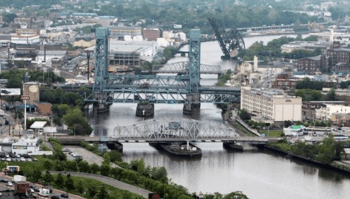
The decline of manufacturing on the lower river has left a post-industrial landscape of abandoned and disused factories and other facilities. In particular, the stretch of the river along downtown Newark came to be regarded in the later decades of the 20th century as particularly wretched. Starting in the 1990s, the lower river became the subject of federal and state urban restoration efforts, which have resulted in new construction along the riverfront, the city of Newark has constructed a riverfront walk from the Jackson St Bridge to the Bridge St Bridge. It is landscaped with trees,plants, and flowers, and benches too. Construction of office buildings has also taken place,including a regional headquarters building for the FBI.
While there has been a decline in the industrial use of the river, recreational use has increased since the early 1990s. There has been a long tradition of high school rowing by Kearny (since 1968), Belleville (1942, New Jersey's first public high school crew team), and Nutley High Schools and, in 1990, the historic Nereid Boat Club (founded in 1868) was revived, broadening participation in the sport of rowing on the Passaic River. In 1999, the Passaic River Rowing Association became the second rowing club along the banks of the Lower Passaic River. Today, the rowing community is very active through the two Rowing Clubs (Nereid Boat Club and Passaic River Rowing Association) and ten high school crews that include Kearny, Belleville, Nutley, Don Bosco Prep, St. Peter's Preparatory School, Montclair, Ridgewood, Teaneck, Westfield, North Arlington (2012-13 School Year), and St. Benedict's Prep. The Passaic River is also host to the annual Head of the Passaic Regatta that has been held since 2001.
Commercial transport on the Lower Passaic hasn't entirely died. On December 3, 2008 a barge was loaded with biodiesel at the former W.A.S. Terminals in Newark, now Passaic River Terminals. Innovation Fuels LLC, one of the terminal's tenants, has plans to continue to sell two barge loads a month of biodiesel to customers in Europe. This is the first commercial barge in the river in over 15 years. Although they experienced some delays with the County drawbridges that have been neglected for years and had some problems with shoaling due to the lack of maintenance dredging, they remain undeterred and the Passaic River represents the cheapest and most efficient method to ship their cargo to its customers.
Vantage points
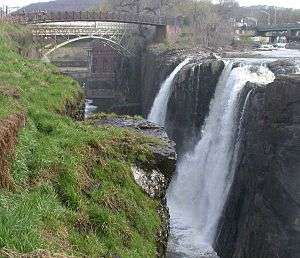
The Passaic River can be accessed via a number of county parks. One notable park is Stanley Park between Summit and Chatham. Other parks along the river are located in Passaic County. As part of the ongoing Newark revitalization effort by the city government, parkland is proposed along the banks of the river.
The Passaic River generally is free of industrialization until it reaches the Summit and Chatham border. The upper portion of the river, above Summit and Chatham, are more natural in appearance and the river has more of a young river character in places. The middle portion of the river flows through natural marsh lands and forested areas in Essex County, which are generally inaccessible and then through heavily populated areas of Passaic County where it is accessible via parallel roads and parks. Lower portions of the river, south of Paterson are wider, more industrialized, and more mature in nature. Kearny Riverbank Park and Riverbank Park in Newark both provide waterfront access. The banks of the lower few miles of the river mainly are industrialized,
Flooding problems
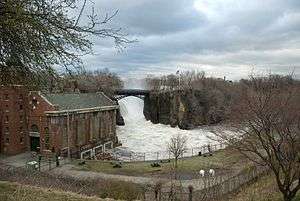
The Passaic River is known for chronic flooding problems during periods of heavy rainfall or snow-melt, especially where the Pompton River joins the Passaic River on the border of Fairfield, Lincoln Park, and Wayne. The two rivers form a sizable flood plain in this area. Building has been allowed in the flood plain and during extreme weather events that occur on a fairly regular basis, homes and businesses in the flood plain become flooded. A plan has been proposed to build the massive 20 mile (32 km) structure, the Passaic River Flood Tunnel, to divert the periodic flood waters southeastly into Newark Bay, thus relieving these flooding problems upstream. Some residents have accepted buy-outs from the federal government while the concept of constructing a flood tunnel is debated, however, many residents still live within the flood plain and flooding appears to be growing worse as the land in the Passaic River basin continues to be developed.
Little Falls River Gauge
The Little Falls River Gauge along the Passaic River is located just south of the junction with the Pompton River, in an area that frequently floods. Flood stage is 7 feet (2.1 m) at this location.
Floods
On February 28, 1902, there was severe flooding of the river. On October 10, 1903 one of the worst floods on record happened. The water crest was 17.50 feet (5.33 m) and severe flooding of Little Falls, Paterson, as well as many other areas along the river. Other high crests were: 12.91 feet (3.93 m) on April 7, 1984; 11.88 feet (3.62 m) on April 18, 2007; and 11.87 feet (3.62 m) on March 16, 2010. On April 23, 2010, Governor Chris Christie issued an order creating the Passaic River Basin Flood Advisory Commission.[8] In January 2011 a report was issued, mentioning the 2010 flood, and the result was for municipalities to change their master plans and change local flood damage prevention ordinances, which would include such things as elevating structures, and to stop expansion into flood zones.[9] The areas considered prone to continual flooding are Acid Brook, Buttermilk Falls, Haycock Brook, Mahwah River, Masonicus Brook, Packanack Brook, Pequannock River, Plog Brook, Pompton River, Ramapo River, Third River, Wanaque River and Wolf Creek. On August 30, 2011 there was another flood with a 14.19 feet (4.33 m) crest. The flood control issue had been considered as far back as 1870 and there were studies in 1939, 1948, 1962, 1969, 1972, 1973, 1987 and 1995 with minimum results from report suggestions.[10]
In the arts and literature
A poem about the river was written by John Alleyne Macnab in 1890, and put to music by Fountains of Wayne.[11]
The river hosted a group of Inuit plantation workers on the run in the 2004 short story, "From Out of the River", by beat laureate Spencer Hash.[12]
The river, and especially its Great Falls, plays a large part in William Carlos Williams's epic poem Paterson.
From 2006 to 2008, writer Wheeler Antabanez traveled the Passaic River and its shores, chronicling his adventures in a special issue of Weird NJ magazine. Nightshade on the Passaic was released as a special issue of the magazine and quickly became its best-selling issue, confirming readers' interest in stories involving the Passaic River.[13] Antabanez intentionally did not want the special issue to be a history lesson of New Jersey or the river, but instead wanted it to be a Huck Finn-style adventure story. In his canoe, Nightshade, Antabanez visits the most dangerous parts of the Passaic, along with several of the abandoned buildings and factories that relied on the Passaic years ago. In addition to the river and the decaying structures that surround it, he also researched murders that involved the Passaic River, including the horrific case of Jonathan Zarate who attempted to dump the mutilated body of his 16-year-old neighbor in the river, but was thwarted by a police officer who happened to pass by at the time.[14]
Tributaries
(As encountered travelling upstream to its source):
- First River (a.k.a. Mill Brook)
- Second River or Watsessing River
- Third River or Yanticaw River
- McDonalds Brook (originally Mineral Spring Brook)
- Weasel Brook
- Saddle River[15]
- Fleischer Brook
- Lyncrest Brook
- Little Diamond Brook
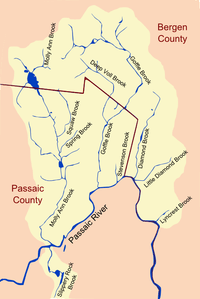
- Diamond Brook
- Stevenson Brook
- Goffle Brook
- Molly Ann Brook
- Spring Brook
- Squaw Brook
- Slippery Rock Brook
- Peckman River
- Singac Brook
- Deepavaal Brook
- Pompton River
- Rockaway River
- Foulerton's Brook
- Spring Garden Brook
- Slough Brook
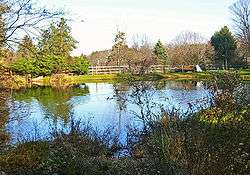
- Canoe Brook
- Salt Brook
- Cory's Brook
- Dead River
- Black Brook
- Great Brook
- Loantaka Brook
- Primrose Brook
- Penns Brook
- Indian Grove Brook
- Naakpunkt Brook
- Taylor Brook
Crossings
See also
- List of New Jersey rivers
- Passaic Formation
- List of bridges, tunnels, and cuts in Hudson County, New Jersey
| Wikimedia Commons has media related to Passaic River. |
References
- PassaicRiver.com. "About the River." Accessed 2010-02-16. Archived October 10, 2008, at the Wayback Machine
- Fallon, Scott (April 11, 2014). "$1.7 billion plan to clean up the Passaic River unveiled". The Record. Retrieved 2014-04-14.
- NOAA Navigational Chart #12337, Passaic and Hackensack Rivers. 23rd Edition, corrected though October–05. Available as a NOAA Raster Navigational Chart at the NOAA Office of Coast Survey RNC Downloads website.
- Lutins, Allen; DeCondo,Anhony P. (Vol. 54, 1999). "The Fair Lawn/Paterson Fish Weir". Archaeological Society of New Jersey. Retrieved 2011-05-05. Check date values in:
|date=(help) - Baxter, Christopher (2011-09-12). "2nd N.J. chemical company held liable for lower Passaic River pollution cleanup." New Jersey On-Line.
- Grant, Meghan. "Environmentalists, Officials Argue Intent of 130 Million to be Obtained from Passaic River Polluters" "NorthJersey.com"
- New Jersey Department of Environmental Protection. Trenton, NJ."NJDEP Fish Advisories. January 23, 2009.
- Governor's order- Retrieved 2015-01-25
- "Passaic River at Little Falls". Weather forecast history. NOAA. November 20, 2014. Retrieved January 25, 2015.
- Report to Governor- Retrieved 01-24-15
- "Song of the Day: 'Song of the Passaic,' Fountains of Wayne". nj.com. Retrieved 8 April 2018.
- "Dirty Little Secrets: In Your Fish". wnyc.org. Retrieved 8 April 2018.
- "Nightshade on the Passaic." Weird NJ, July 2008 Special Issue, Stock No. 9631. OCLC 420919270.
- Klein, Corey. "Where we see a beast, he sees a beauty." South Bergenite. July 2, 2008.
- Scott, William W. (1922). Passaic and Its Environs, Volume I. Lewis Historical Publishing Company, Inc. pp. 138–140.
External links
- Lower Passaic River Restoration Project
- Passaic River Coalition
- Passaic River Boat Club
- Passaic River Institute, Montclair State University
- North Jersey District Water Supply Commission
- Delaware and Hudson Canoe and Kayak Club: Passaic River- Source to Mouth
- My Passaic River Kayak Trip - 90 Miles of Fun in Northern New Jersey - June 2000 - by Steve Garufi
- Great Swamp National Wildlife Refuge
- U.S. Geological Survey: NJ stream gaging stations
- Passaic River Rowing Association
- Nereid Boat Club
- The Passaic Flood of 1903 at Project Gutenberg (Water-Supply and Irrigation Paper No. 92)
